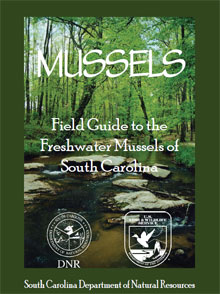Freshwater Fish - Species
Species Specific Regulations
Asian clam
Freshwater Fishing License required.
Asian clam (Corbicula fluminea)
Description: (Anatomy of a Shellfish)
The shell is fairly small, seldom exceeding 50 mm in length, very solid, ovate when young, and triangular in outline when mature. There are three cardinal teeth directly below the umbos in each valve. The periostracum is a light yellowish-olive to cream colored in immature clams, changing with age to tan, olive, and finally, dark brown to black in old individuals. Very young individuals possess a characteristic dark stripe or band on the anterior slope of the valves. The nacre is white to a shiny light purple.
Some tips to help identify native species from the invasive Corbicula. An overall good rule of thumb to remember is Corbicula are about nickel to half dollar in size, triangular to subtriangular in shape, whereas native mussels are larger than a half dollar, oval to quadrangular or subquadrangular in shape.
Range: This species is found in the Savannah, Cooper, Santee, Pee Dee, Little Pee Dee, Edisto, Waccamaw, and Salkahatchie rivers; the intracoastal waterway.
Average Length: 50 mm
Life Expectancy: Approximately 1-7 years
Preferred Habitat
Mussels were historically abundant in most permanent rivers and streams in North America. Sometimes, mussels can be found in temporary bodies of water such as sloughs and oxbow lakes, that occasionally receive water from rivers during flood events. Mussels are not usually found in streams that experience frequent drying or dry periods of long duration.
Food Habits
- Asian clams are filter feeders that remove particles from the water.
- They feed primarily on phytoplankton (algae), which they filter from the sandy or muddy bottom of streams, lakes, or canals.
Reproduction
- After reaching maturity these clams produce eggs then followed by sperm.
- They can self-fertilize, and release up to 2,000 juveniles per day, and more than 100,000 in a lifetime. Juveniles are only 1 mm long when discharged, and take one to four years to reach maturity (Wikipedia).
Miscellaneous
The Asian clam (Corbicula fluminea) was first reported in the United States in Washington's Columbia River in the 1930s. It was likely introduced intentionally for harvest and consumption purposes. Corbicula fluminea spread mostly through human activities, such as bait bucket dumping, aquaria releases into streams or canals, and intentional releases by people who bought the clams at food markets. Asian clams may also have been introduced accidentally in shipments of imported aquaculture species. Another pathway for dispersal is the passive movement of larvae in water currents.
Since the initial introduction into the United States in Washington's Columbia River in the 1930s, the Asian clam spread across the country, with the first reports in South Carolina from the Pee Dee River in the late 1960s or early 70s. From there it spread to the Savannah River, the Santee Rivers, and throughout the state. Ecological impacts of Asian clam infestations include the altering of benthic substrate and increased competition with native species for food and habitat resources. Periodic massive die offs of the Asian clam have been linked to mortality of native freshwater mussels, and the clam has been blamed for the decline and local extinctions of several native freshwater mussel species. Corbicula can be used as baitfish by anglers; however other native species cannot be taken without a permit from the department (Section 50-13-510).
More information on mussels
Literature Cited
US Geological Survey. NAS Nonindigenous Aquatic Species
http://nas.er.usgs.gov/queries/factsheet.aspx?speciesid=92
Wikipedia - The Free Enclopedia. Corbicula fluminea
https://en.wikipedia.org/wiki/Corbicula_fluminea


